Equipment Funded
Your donations directly fund essential patient care equipment at the Thunder Bay Regional Health Sciences Centre.
Here's a look at the impact you've had over the past several years.
2024 | 2023 | 2022 | 2021 | 2020 | 2019 | 2018
Equipment Funded in 2024 ($6,604,801)
1.5T MRI Upgrade
(Diagnostic Imaging, $750,000)
Equipment upgrade for Diagnostic Imaging.
MRI is being used for more and more types of scans, and the Hospital currently images approximately 15,000 patients per year. New software upgrades for this MRI scanner can help improve patient care and keep Diagnostic Imaging up to date with current technology without replacing the whole unit. Software upgrades will reduce the need for patient repositioning, reduce the need to replace coils, and compensate better for patients who move slightly during the scan due to involuntary movements. These improve both image quality and patient comfort.
Thunder Bay Breast Cancer Support Group
($5,000)
Program to support breast cancer survivors.
The Thunder Bay Breast Cancer Support Group (TBBCSG) is a pro-active, peer-led, self-help group for breast cancer survivors in a safe and inclusive space for women and men. The group hosts monthly meetings except in summer months. Other planned activities include Yoga, Craft/Painting night, Genetics Presentation and a Survivor Tea during Breast Cancer Awareness Month.
Automated Medication Dispensing Cabinet
(Diagnostic Imaging, Ambulatory Care, Cancer Centre, $250,000)
New Equipment for Diagnostic Imaging, Ambulatory Care, and Cancer Centre.
Automated medication dispensing cabinets are proven to improve medication speed and patient safety. Rather than travel to the pharmacy to manually fill prescriptions, they can be reviewed and approved electronically. Phase 7 provides a cabinet for Diagnostic Imaging, Ambulatory Care, and expansion of the Cancer Centre.
HDRB Applicator Replacements
(Cancer Centre, $50,945)
Equipment Replacement replacement for High-Dose Rate Brachytherapy.
High-Dose Rate Brachytherapy (HDRB) uses tubes called applicators to deliver the radioactive particles near the cancer tumour site. The size and number of tubes depend on several factors including the type and location of the tumour as well as patient factors. These applicators wear out over time, and are now due for replacement.
Linear Accelerator (LINAC)
(Cancer Centre, $500,000)
Construction related to LINAC installation in Radiation Therapy.
LINACs are key pieces of treatment equipment, delivering targeted radiation doses to cancerous tumours. Cancer rates have risen in Northwestern Ontario to the point where we need three active LINACs instead of two. This grant covers construction and other installation costs to add a new LINAC to the (existing) third radiation treatment suite planned during the Hospital's construction 20 years ago.
Patient Lifts
(ICU & Diagnostic Imaging, $20,130)
Equipment Replacement to assist with repositioning or moving patients.
Patients at the Hospital who are non-mobile or have restricted mobility need assistance while travelling to other areas of the Hospital and/or repositioning to avoid bed sores. Current ceiling lifts are nearing end of life and are no longer safe. This grant funds three new ceiling lifts in Critical Care and Diagnostic Imaging for improved patient and staff safety.
Cardiovascular Imaging System (PACS)
(Cath Lab, $500,000)
Equipment Upgrade & Replacement to manage Cath Lab images for Cardiovascular Program.
The Cardiovascular PACS (picture archiving and communications system) stores a crucial part of the patient record. The imaging system manages all Cath Lab imaging results from angiograms, pacemaker insertion, and other cardiac diagnostics and procedures. Authorized healthcare professionals including those at the University Health Network (UHN) partner site in Toronto can access these images for future diagnostics and patient monitoring. This new system will replace an aging system officially at end of life.
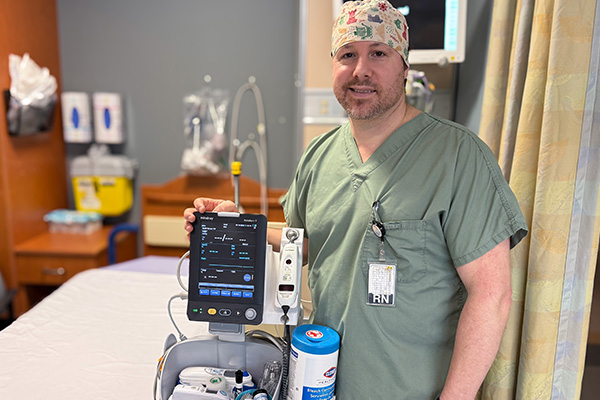
Hospital Vital Signs Monitors (VSMs)
(All Areas, $78,528.30)
New Equipment upgrade and replacement for Cardiovascular Program.
Vital Signs Monitors (VSMs) constantly measure patient vital signs such as heart rate and oxygen levels, and alert staff if those levels go outside a predetermined range. This is especially crucial for patients before and after cardiac procedures. These new monitors will replace and upgrade aging monitors in several hospital areas.
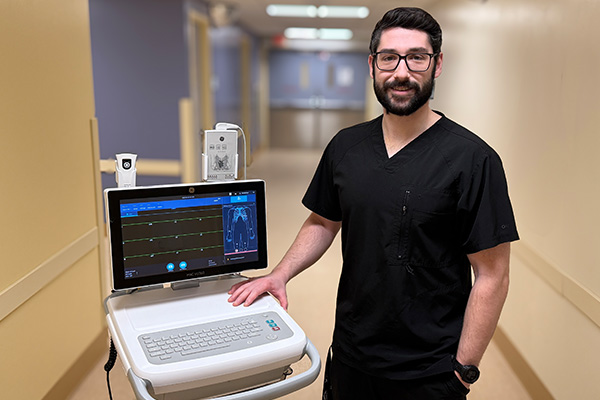
ECG Machine
(Cardiovascular Program, $23,877)
New Equipment to increase diagnostic capacity for the Cardiovascular Program.
An electrocardiogram or ECG records electrical activity in the heart to help diagnose specific problems including heart attack. The number of ECGs performed at the Hospital is currently over 60,000 tests per year – and that number is growing. The Cardiovascular Program recently added a new shift to meet patient need. This additional ECG unit increases diagnostic capacity for timely testing.
Renal Bundle
(Renal Department & Regional Sites, $96,652.45)
Equipment Replacement replacement for local and regional Renal sites.
This bundle includes a new, comfortable dialysis chair to replace an aging chair at the Thunder Bay site; a replacement ice machine for the Fort Frances site to replace an aging unit; an ice machine for the Sioux Lookout site for patient comfort; three additional transonic flow meters, which ensure proper dialysis speed; and two new home dialysis bays at our training facility in the Medical Centre Building to increase capacity to five training bays to meet the needs of this growing program.
Da Vinci Robot Additional Equipment
(Operating Room, $354,933.77)
New Equipment used for minimally invasive surgery (MIS) in the Operating Rooms.
Minimally invasive surgery (MIS) using robotics offers many patient advantages including smaller incisions, faster recovery times, and lower risk of infection. However, due to the nature of this type of surgery, the instruments used are much longer than normal surgical tools – so long that they do not fit in a conventional sterilizing unit. Further, it makes MIS surgery on a standard OR bed difficult. This grant will purchase two new MIS-ready sterilization units as well as a specialized bed designed for MIS.
MRI-Compatible Anaesthesia Machine
(Diagnostic Imaging, $165,947.80)
New Equipment to provide sedation to patients who need it during MRIs.
Patients often require sedation using anaesthesia during MRI scans. However, Diagnostic Imaging (DI) currently does not have an anaesthesia machine that can work in tandem with our MRI. Previously, DI used other methods. That practice is put on hold for adults, and all children who need anaesthesia during MRI are now sent to southern Ontario. This equipment will improve patient care and safety, and reduce patient travel for DI procedures they can receive here.
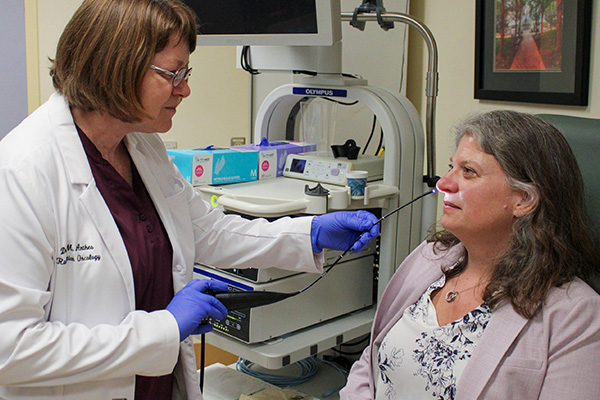
ENT Scope Bundle (Rhinolaryngoscopes/Video Tower)
(Cancer Centre, $106,985)
New Equipment to image nose and throat for obstructions, cancer, etc.
Modern rhinolaryngoscopes can take video of the nose and throat so doctors can view possible obstructions, injuries after a trauma, cancer, and other conditions. Currently, Ambulatory Care has one aging scope that does not record video – crucial for patient follow-ups. Further, growing need means Ambulatory Care needs at least two new scopes to meet capacity. A third specialized scope for children is more comfortable for the patient and frees up OR time.
Flexstation3 Microplate Reader
(Thunder Bay Regional Health Research Institute, $189,951.20)
Research Equipment to find a new breast cancer drug.
About 90% of cancer deaths are related to metastasis when cancer cells migrate to other parts of the body. This happens at an alarmingly high rate in triple-negative breast cancer (TNBC). Researchers at the Thunder Bay Regional Health Research Institute have found a promising new way to inhibit metastasis by blocking a receptor in the cell. The first step is to test in the lab using TNBC cells taken from biopsies. This diagnostic lab device will help researchers test this new technique's effectiveness. If successful, they potentially could develop a drug to help fight metastasis in TNBC, in turn reducing cancer deaths.
Fujifilm Sonosite Point of Care Ultrasound Visualization Tools
(All Areas, $42,184)
New Equipment for better, safer, more comfortable vascular access.
About 90% of inpatients need a needle insertion for vascular access to provide nutrition, antibiotics, chemotherapy, and other patient interventions. For some including patients with small, hard-to-find veins, repeated poking can be uncomfortable and lead to complications. Ultrasound visualization tools help guide the needle for better patient comfort and safety.
Nathanson and Thompson Retractors
(Operating Room, $17,551.55)
New Equipment to expand capacity for bariatric surgeries.
Bariatric surgeries use specialized tools including Nathanson and Thompson retractors. Right now, the hospital is limited to 3-4 bariatric surgeries per day. These extra retractors will increase capacity to allow for another surgery per day.

MIS Operating Room Equipment
(Operating Room, $129,415)
New Equipment to expand MIS capacity.
Minimally invasive surgery (MIS) provides many patient comfort and safety benefits including shorter recovery times and fewer complications. Currently, three OR suites are equipped for this growing area of surgery. This grant doubles capacity to six MIS-enable OR suites.
Bipolar TUR Urology Instruments
(Operating Room, $15,357.52)
New Equipment to improve prostate and bladder surgery.
Currently, surgeons use “monopolar” surgical instruments for bladder and prostate operations. However, the newer bipolar technique can be just as effective while reducing the risk of bleeding. These new tools will allow surgeons to improve patient safety and care during prostate and bladder surgery.
Digital Chest Drainage - Thoracics
(Operating Room, $31,586)
Equipment Upgrade upgrade to monitor air and fluid levels after surgery.
Chest tubes drain air and fluid after thoracic (chest) surgery. These are monitored to determine when an inpatient can leave the Hospital. Current chest drainage systems can accurately measure fluids, but air leakage is subjective and done by observation. This new system allows an accurate measure of air as well for better patient safety and perhaps a shorter recovery period.
Eye Surgery Stretcher
(Operating Room, $7,488.92)
New Equipment to assist with cataract surgery.
Specialized eye surgery stretchers (beds) help keep the patient comfortable and immobile during delicate eye/cataract surgery and recovery. Surgical Day Care and the Operating Rooms currently have six stretchers in working order, falling below the capacity needed for 14 surgeries per week. This stretcher replaces aging stretchers that are no longer fixable.
Omni Hysteroscopes and Trays
(Operating Room, $40,124)
New Equipment for faster gynaecological procedures and better capacity.
Hysteroscopes allow surgeons to view the inner walls of the uterus and perform certain procedures such as polyp removal and IUD insertion. However, often surgeons have to switch from one set of instruments to another during procedures, add time and in turn patient discomfort. These four new hysteroscopes with trays contain all instruments needed, reducing uncomfortable waiting, upgrading equipment, expanding capacity, and streamlining services.
Margin Marker (Breast Cancer)
(Operating Room, $98,019)
New Equipment used during breast tumour surgery.
Before breast tumour surgery or lumpectomy, a thin wire is inserted into the breast to mark the location. However, new technologies such as a "magseed" (a 1x5mm magnetic device) offer many advantages. Perhaps the biggest is that they can be inserted days or weeks before the surgery. Because wires are inserted the day of the surgery, any difficulties can lead to delays. Further, if a surgery time becomes available, it is easier to add someone from the wait list. Lastly, two surgeons can operate on the same day rather than just one, which means increased capacity and reduced overall surgical wait times.
Middle Ear Instruments
(Operating Room, $9,320.64)
New Equipment used for ear surgery.
The Hospital performs more ear surgeries than ever. These new specialized instruments for middle ear surgery helps replace aging instruments, increases capacity, and provides our new ENT surgeons with the latest technology.
Hillrom Centrella SMART Patient Beds
(All Areas, $200,000)
Equipment Upgrade & Replacement for comfort and patient/staff safety.
Today's SMART inpatient beds use vastly improved technology compared to previous beds. The bed mattresses themselves are made from a specialized material that reduces the risk of pressure (bed) sores. Better mechanical controls make it safer and easier to move patients in the bed as needed. Extra features including bed underlighting that indicate the patient is in bed and built-in respiration monitor helps staff during rounds. These new beds will upgrade beds already in use throughout the Hospital.
Patient Identification Mobile System (MobiLab) for Blood Collection
(Laboratory Services, $326,048)
New Equipment to help streamline blood specimen collection.
Staff draw approximately 1,000 blood samples from patients at the Hospital every day. These need to be carefully matched to the patient so that the right results are attached to the correct patient file for improved diagnosis and monitoring. The MobiLab patient identification system makes labelling and tracking patient samples simpler to reduce the risk of ID errors that could result in misdiagnosis.
Miscellaneous Lab Equipment
(Laboratory Services, $200,000)
Equipment Upgrades & Replacements for lab analysis/patient diagnosis.
Laboratory Services at the Hospital tests 7,500 samples per day or 2.7 million samples per year to help diagnose and monitor a range of diseases and conditions in patients. It requires cutting-edge technology for timely results and better patient safety. This grant replaces and upgrades aging equipment: a spectrophotometer to determine chemicals in a sample, an electrophoresis to separate proteins in blood, freezers and a fridge to keep samples at appropriate temperatures, a centrifuge to spin blood, a cell washer to prepare blood for analysis, a microtome to cut extremely thin tissue samples for microscope analysis, and a new microscope for examining cell/tissue samples.
SPECT Camera
(Diagnostic Imaging, $482,072)
Equipment Upgrade & Replacement for imaging diagnostics – Nuclear Medicine.
The SPECT or gamma ray camera uses nuclear medicine to image certain areas of the body such as bone scans and kidneys. The current camera, purchased in 1999 at McKellar, is past end of life and prone to breakdowns. This replaces that aging unit and provides many upgrades in technology.

Hana Table – Anterior Hip Positioner
(Orthopaedics, $108,577)
Equipment Upgrade & Replacement to position and support the thigh bone during hip replacement surgery.
Hip replacements require working with the thigh bone, the biggest, strongest bone in the body. This new Hana Table features a special attachment that can position and support the thigh bone at precise angles, making hip surgery easier for orthopaedic surgeons and the OR team.
Foot & Ankle Retractor Instrument Set
(Orthopedics, $31,204)
New equipment used during foot and ankle surgery.
Currently, orthopaedic surgeons have one set of specialized instruments for foot and ankle surgeries. However, these sets need to be sterilized between uses. This additional set increases capacity so that more surgeries could possibly be done per day and to avoid delays if one set is compromised requiring re-sterilization.
McCullouch Retractor (Spine)
(Orthopedics, $15,273)
New equipment used during spinal surgery.
Retractors help hold aside skin and tissue layers so that the surgeon can focus on a specific area. Currently, spinal surgeons use general retractors. This new McCullouch Retractor is specially designed for spinal surgery, providing better tools for our surgeons and increasing capacity for more spinal surgeries per day.
Microchoice Drill/Saw and Set
(Orthopedics, $31,213)
New equipment used during orthopaedic surgery.
Drills and saws are the workhorses of orthopaedic surgery and are used during shoulder, trauma, and other surgeries. This new set will increase capacity to meet growing need and reduce the risk of delays.
Quick Latch Scopes and Containers
(Orthopaedics, $16,100)
New equipment used during knee surgery.
X-rays and MRIs only go so far, and sometimes surgeons need to view a knee directly using a camera (scope) to diagnose disease or for treatment planning. These two new scopes allow surgeons a minimally invasive way to do examinations that is faster and easier, improving patient care and recovery. The new scopes expand capacity for orthopaedic surgeons to meet growing demand.
Tourniquets and Stands
(Orthopaedics, $62,942)
New equipment used during orthopaedic surgery.
Pneumatic tourniquets are used in almost every orthopaedic surgery for near-bloodless operations. Not only is this beneficial to patient health, it allows surgeons a clear view of the surgical area for better safety, reducing operating risks. This grant covers the purchase of three tourniquets and accompanying stands to increase orthopaedic surgery capacity.
Paediatric Crash Cart and Supplies
(Sim Lab, $5,836.51)
New equipment used in the Sim Lab.
Simulation training is recognized as an excellent teaching tool for learners of all levels and professions including non-medical staff at the Hospital. However, the Hospital Sim Lab currently does not have a Paediatric Crash Cart to train with. Currently, participants use the adult version, but it is different enough that training is not as good as it could be. Paediatric emergencies add another level of urgency for all participants, so training with the right equipment is crucial. This new learning component helps provide staff the training they need.
Sim Lab Mannequins
(Sim Lab, $6,713.90)
New equipment used in the Sim Lab.
One of the advantages of simulations labs is that it allows healthcare professionals to practice new skills and techniques in real-world situations before treating live patients. These new mannequins allow for advanced nursing training not previously available in the Sim Lab such as chest tube care, multiple wounds, and other scenarios.
Stryker Psychiatric Bed and Mattress
(Adult Mental Health, $22,275.32)
New equipment used to improve safety for Adult Mental Health patients.
Safety is a top priority for patients in Adult Mental Health (AMH) to prevent harm to the patient and others in times of crisis. Standard medical beds can compromise this level of safety with moving and/or removable parts. This new style of bed, specially designed for these situations, provides added safety and comfort for the patient, other patients in the unit, and Hospital staff. AMH plans to replace all standard medical beds with these improved beds over the coming years.
Resuscitator Level 1 Rapid Infuser
(Intensive Care Unit, $22,374.95)
Equipment upgrade & replacement to replenish fluids in critical patients.
When patients have serious injuries, significant bleeding, or other critical conditions, they lose a lot of fluids. These include blood loss, saline, and other specific solutions critical to cell and organ function in the body. The rapid infuser quickly replenishes those fluids directly into the patient's circulation. This new, upgraded unit replaces aging equipment.
Q-NRG+ Metabolic Monitor
(Intensive Care Unit, $56,040)
New equipment to measure caloric intake for critically ill patients.
Patients in Critical Care (ICU) require a specific number of calories every day. A Registered Dietitian estimates caloric intake for each patient based on size, nutrition level, drug use, and other factors. However, current calculation methods are only accurate about 50% of the time. This new metabolic monitor will allow for more accurate measurements. Improved nutrition leads to shorter ICU stays, less risk of infection, antibiotic use, ventilator use, and other benefits to the patient.
Point of Care Ultrasounds (POCUS)
(Emergency Department & Intensive Care Unit, $148,381.76)
New equipment to help assess patients in the Emergency Department and ICU.
An ultrasound scan gives healthcare professionals insights about a patient's condition. In the Emergency Department, it can help diagnose a patient by finding abnormalities in the abdomen, locating a build-up of fluids, visualizing heart function, and finding information about other areas of the body. In Critical Care (ICU), it can save a long and complicated trip to Diagnostic Imaging. These two new, upgraded units replace aging equipment used daily.
Perfusion Pump ECLS
(Intensive Care Unit, $200,313.18)
New equipment to provide next-level life support.
Ventilators are a type of life-support equipment that help patients breathe. However, sometimes patients require a step beyond breathing including replacing the oxygen/carbon dioxide exchange that happens in normal lungs. This happens in cases such as pneumonia or during surgery when the heart or lungs need to be stopped. The extracorporeal life support (ECLS) perfusion pump is technology new to the Hospital that provides this next-level life support. In Critical Care (ICU), it gives doctors more time to treat underlying conditions while the ECLS takes care of normal function. Previously, patients requiring ECLS care would need to travel, causing unnecessary delays in treatment and unnecessary stress on family.
Workstation on Wheels (WOW) with Battery
(Intensive Care Unit, $6,924.09)
New equipment to assist healthcare professionals with ICU rounds.
Rounds in Critical Care (ICU) is often a multi-disciplinary event with doctors, nurses, therapists, and others come together to talk about a patient. Currently, the patient's up-to-date chart is stored in a central workstation in the unit. This means running back and forth to the central workstation or carrying a small laptop – not ideal for group rounds. This portable workstation will allow all professionals to easily access information, speeding up rounds for more timely patient care.
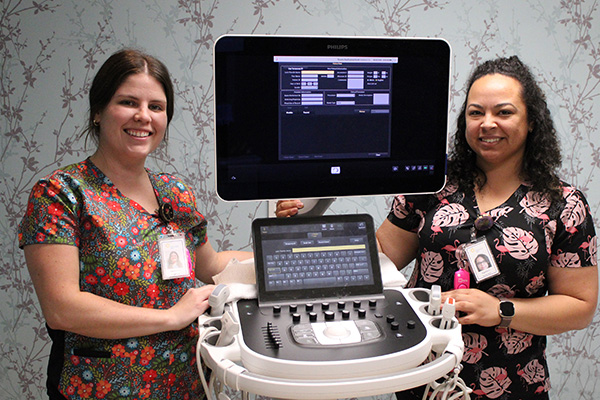
Ultrasound Machine Replacement
(Diagnostic Imaging, $185,000)
New equipment to increase ultrasound capacity in Diagnostic Imaging.
Currently, Diagnostic Imaging provides about 2,000 ultrasounds per month for vascular, musculoskeletal, interventional, and general scans using five units. One of those units is 10 years old and nearing end of life. Breakdowns to any of the units can lead to delays in care for patients referred from the Emergency Department as well as outpatients. Adding this new unit will increase capacity and will reduce the impact of issues related to aging equipment.
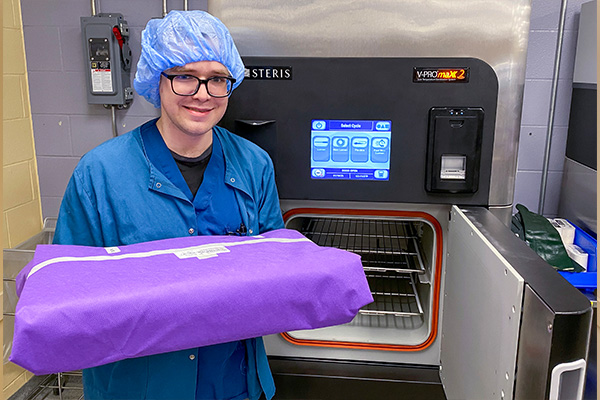
V-Pro Sterilizer
(Medical Device Reprocessing Department [MDRD], $139,691)
New equipment to sterilize medical instruments.
Sterilization is crucial to protect patients and staff from infection. The Medical Device Reprocessing Department (MDRD) runs 24/7 to ensure all instruments are sterilized quickly so that they are available again as soon as possible. This new sterilizer replaces an aging unit, which would cause innumerable delays throughout the Hospital, should it break down. It also features “low-temperature” sterilization, which is still hot enough to thoroughly clean items but low enough that it can potentially extend the life of instruments and devices.
Wheelchair and Staxi Repairs and Purchases
(Diagnostic Imaging, $20,054.04)
New equipment to safely and comfortably transport patients within the Hospital.
Wheelchairs and Staxis – specially designed wheeled transport – are used by patients, families, and staff at the Hospital every day. Normal wear and tear means that chairs much be replaced regularly to maintain the fleet. If too few chairs are available, it can lead to delays in patient transport. These delays can snowball if, for example, patients arrive late for diagnostic testing or scans.
Women & Children Bundle
(Women & Children's Program, $238,299.91)
New equipment for Women & Children's Program.
This bundle of equipment includes vital equipment: infant warmer, delivery carts with sterile instruments used during delivery, infant scale, epidural carts for pain management during delivery, bladder scanner for mother post-delivery, phototherapy for babies with jaundice, a Starlight Fun Centre to entertain children in Hospital, cribette to more safely transport infants around the Hospital, a central vital sign monitoring system for the Paediatric unit, and a temperature-controlled isolette for newborns. In all cases, equipment is nearing/past end of life and/or does not meet current patient care and safety standards.
Equipment Funded in Regional Hospitals
Mammography Unit, Kenora
(Regional Cancer Program, $100,000)
Equipment upgrade & replacement of aging mammography unit.
As a satellite site of Regional Cancer Care, the Lake of the Woods District Hospital (LWDH) provides over 1,700 mammographies annually to patients in the area including 10 remote First Nations. Its aging mammography unit, which can break down leading to week-long repairs, is at end of life. This grant contributes to the cost of a new, upgraded unit that will be able to provide new standards of imaging including contrast-enhanced breast imaging and tomosynthesis (3D mammography).
Ventilator and Novum IQ Pumps, Marathon
(Regional Cancer Program, $38,200)
Equipment for Emergency Department patients in Marathon.
The Emergency Department at North of Superior Healthcare (Wilson Memorial) in Marathon needs a new ventilator and IV pumps for better patient care at its facility, particularly for cancer patients. This new equipment replaces and upgrades aging equipment to ensure safe and timely patient care.
Chemotherapy Chair, Fort Frances
(Regional Cancer Care, $7,343.87)
Equipment for regional outpatient chemotherapy program.
Closer-to-home care includes providing equipment to satellite cancer programs at regional hospitals. This chemotherapy chair for Riverside Health Care in Fort Frances replaces an aging chair for better patient comfort. It also improves patient safety as older chairs become harder to clean, increasing risks of infection to already-compromised patients.
Gynaecological Stretcher, Fort Frances
(Regional Cancer Care, $7,248)
Equipment to make OB/GYN examinations easier for patients and doctors.
Sometimes, an OB/GYN examination is needed for patients about to undergo chemotherapy. Currently, the physician at Riverside Health Care in Fort Frances uses a standard stretcher. However, this makes the exam less comfortable for the patient and more difficult for the physician. This specialized stretcher will be an improvement for all and could be used as a general stretcher as well.
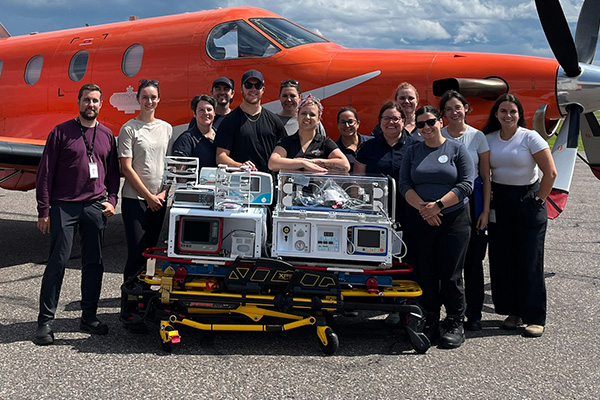
Neo-natal and Infant Transport Team, Across Northwestern Ontario
(Women & Children's Program, $88,007.25)
Equipment to support emergency transport of regional infants to the Hospital
Time is of the essence in an emergency – and with infants, it's exponentially so. The Hospital developed a specialized Neo-natal and Infant Transport Team to safely transport infants in the region who need the advanced care services provided at the Hospital. This funding provides the team with a second “deck” or set of emergency transport equipment including an infant ventilator and infant defibrillator to ensure safe transport for two infants at a time, reducing wait times in situations when two infants require transport at the same time.